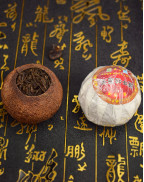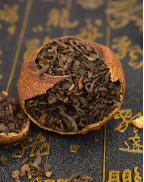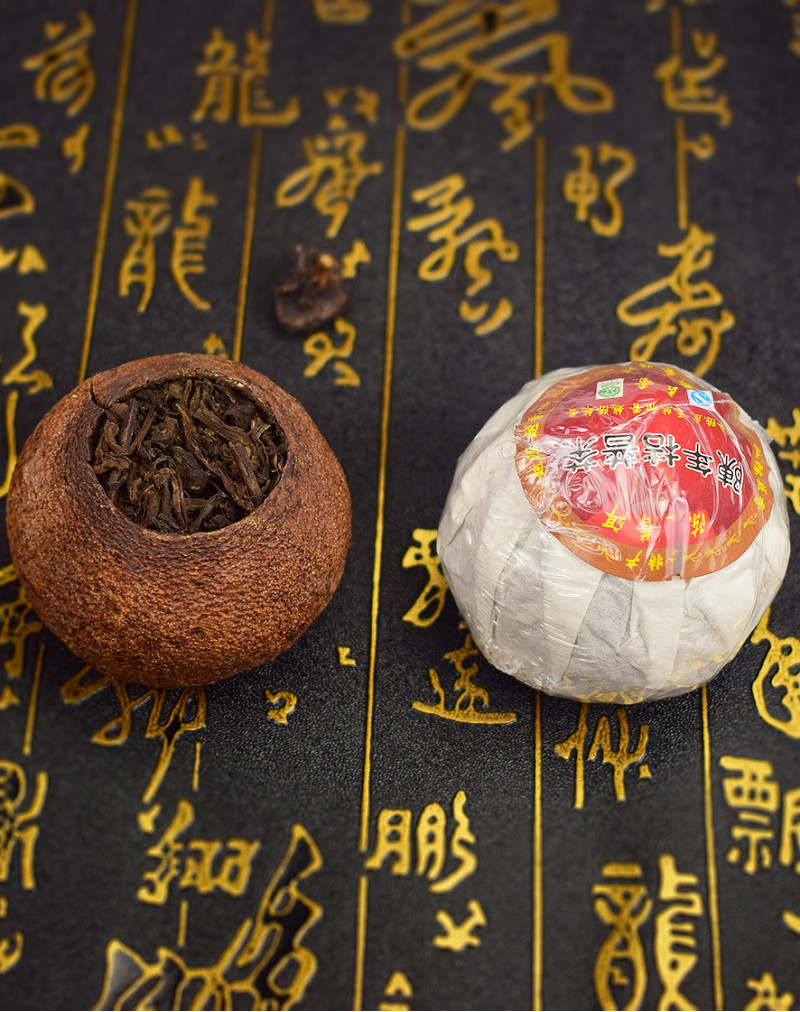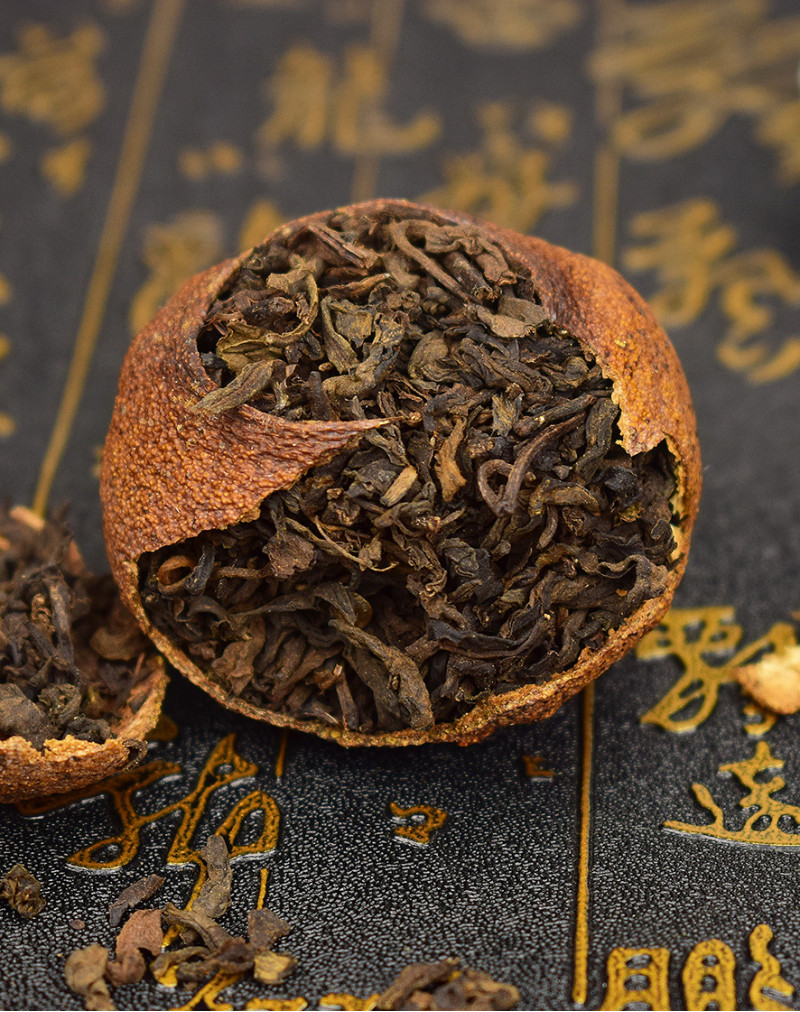Aged Orange (Chenpi ) Pu-erh
- Product Code: simple
- Availability: In Stock
Basic Info
Name: Aged Orange (Chenpi) Pu-erh
Other Names: Mandarin orange pu-erh, Mandarin Pu-erh
Category: Pu-erh tea
Origin: Yunnan (Pu-erh), Guangdong (Orange)
Taste & Aroma: Unique flavor and aroma, with hints of citrus and earthy notes from the Pu-erh tea
Liquor: Yellowish,clear and bright
Harvest Period: 2020
Altitude: 1000M above sea
Fermentation: Post-fermented
Season: Spring tea
Item Form: Loose leaves
Ingredients: Hand-picked natural tea buds and leaves / Xinhui orange peel
Shelf Life: 3-10 years
Storage: Stored in cool, airtight, opaque, dorless,dry containers
Aged Orange (Chenpi ) Pu-erh
Get ready to indulge in the perfect balance of smooth, earthy notes from our Orange Pu-erh, enhanced by the zesty essence of aged Chenpi. This combination creates a one-of-a-kind fusion that will delight your taste buds and invigorate your senses. Immerse yourself in the unrivaled complexity and health benefits that this extraordinary tea has to offer.
Introduction
Orange Pu-erh ("Chenpi Pu-erh" (陈皮普洱) ), also known as "aged mandarin pu-erh" or "mandarin pu-erh," is a type of
Chinese fermented tea that is made by stuffing pu-erh tea leaves into the skin of mandarin oranges and allowing
them to age together.
The word "陈皮chenpi" translates to "aged peel," referring to the sun-dried skins of mandarin oranges or tangerines that are used in the tea. It originates from the Yunnan province of China.
Disclaimer:
The following content discusses the potential health benefits of dried tangerine peel, based on traditional Chinese medicine theories. However, it is important to note that this article is for informational purposes only and should not be considered as medical advice. Dried tangerine peel should not be used as a direct substitute for medication or any prescribed treatment. Before incorporating dried tangerine peel or any other herbal remedies into your healthcare routine, it is crucial to consult with a qualified healthcare professional to assess your specific health condition and potential risks.
Health Benefits
Orange Pu-erh is highly valued for its potential health benefits, which include aiding digestion, reducing cholesterol, and boosting the immune system. It is also prized for its cultural significance and is often used in Chinese tea ceremonies as a symbol of hospitality and friendship.
Over time, the practice of adding orange peel to Pu-erh tea became more common and evolved into a specific type of Pu-erh known as "cheng pi" Pu-erh or orange peel Pu-erh. The process of making orange Pu-erh involves adding dried orange peel to the tea leaves during the fermentation process, which gives the tea a distinctive orange flavor and aroma.
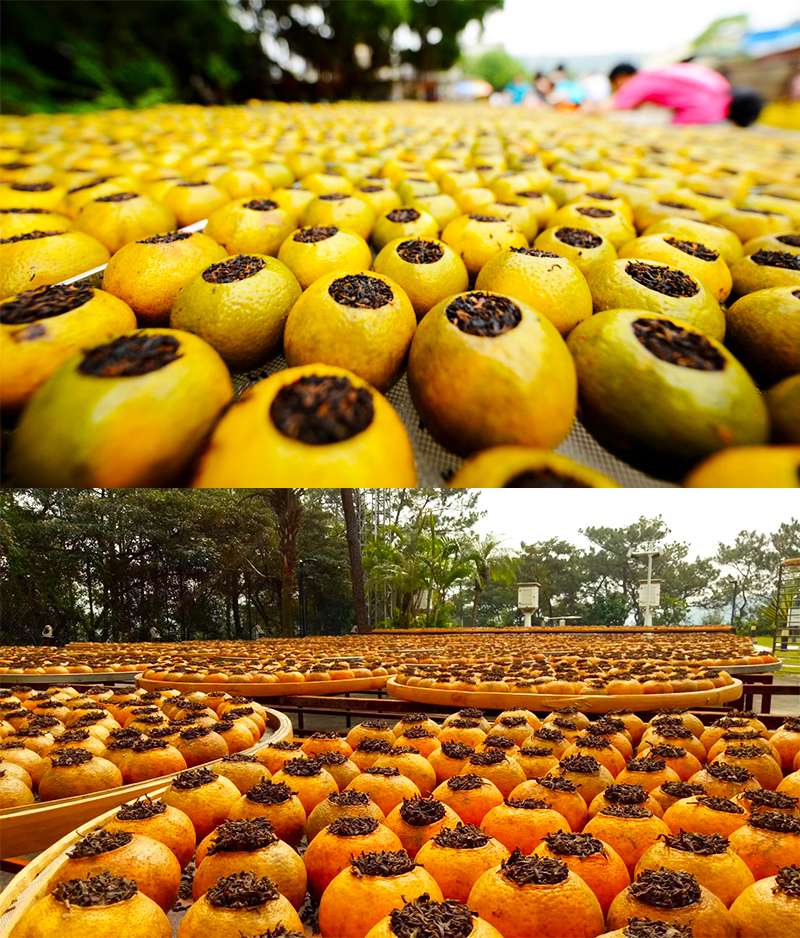
Semi-Finished Orange Pu-Erh Tea In The Sun
Show Full Description
The functions of Tangerine peel in TCM theory
In traditional Chinese medicine (TCM), tangerine peel (or 陈皮 chen pi in Chinese) is used for its aromatic and medicinal properties. Tangerine peel is the dried outer peel of the tangerine fruit, which is commonly used in cooking and herbal medicine in China.
Tangerine peel is believed to have a warming and drying effect on the body, making it useful for treating conditions related to dampness or coldness in the body. In TCM, it is used to regulate the flow of Qi (vital energy) in the body, improve digestion, and relieve symptoms such as bloating, nausea, and indigestion.
Additionally, tangerine peel is often used as an ingredient in TCM herbal formulas to help enhance the effects of other herbs and improve their flavor.
Overall, tangerine peel is a versatile herb in TCM with a variety of therapeutic uses. It is commonly used to treat digestive and respiratory conditions and is known for its ability to regulate the flow of Qi and enhance the effects of other herbs.
Xinhui Tangerine peel
Xinhui Cheng Pi (Tangerine peel) is a type of tangerine peel that is highly valued in Traditional Chinese Medicine (TCM). It is a specific variety of tangerine peel that is grown in Xinhui, a district in the Guangdong province of China. Xinhui Cheng Pi is known for its high quality and is considered to be one of the best varieties of tangerine peel used in TCM.
Xinhui, formerly known as Gangzhou, is located in the south of the Tropic of Cancer and has a subtropical marine climate with an annual average temperature of 23.8 ℃ and rainfall of 1893.1 mm. Xinhui District is famous throughout China for its rich tangerine peel.
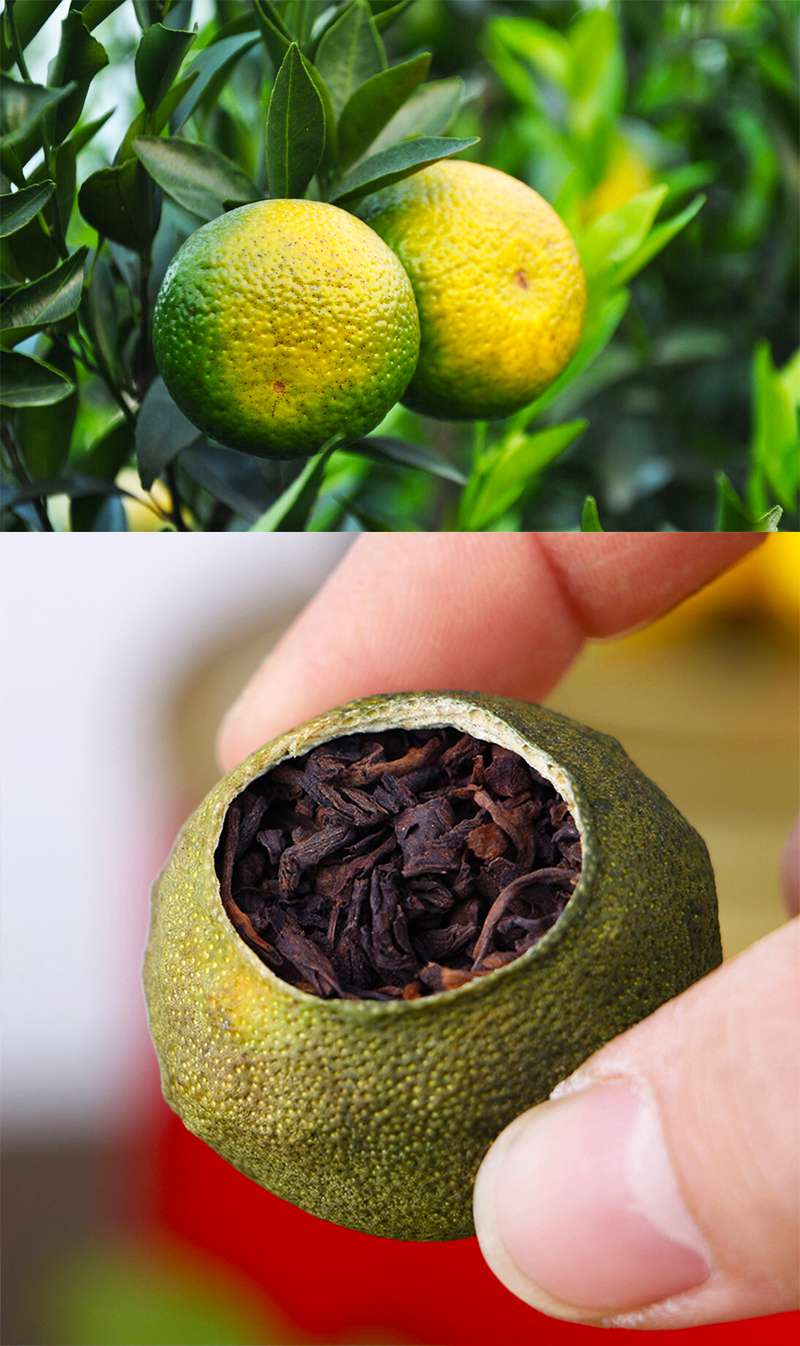
Small Green Mandarin Pu-Erh Tea
Yunnan
Yunnan Province is one of the main tea-producing regions in China, with a long history of tea cultivation. The province has a favorable climate, fertile soil, and diverse geography, making it ideal for the growth of a variety of tea plants.Pu-erh tea is a type of fermented tea that is native to the Yunnan province in China. This tea is known for its unique flavor, aroma and health benefits.
Hwo to make Orange Pu-erh?
To make Orange Pu-erh, the mandarin oranges are first carefully selected for size and ripeness, then a small hole is cut in the top of the fruit and the flesh and juice are removed. The hollowed-out orange is then filled with compressed pu-erh tea leaves and left to dry in a warm, dark place for several weeks to allow the tea to absorb the orangey flavor and aroma of the mandarin peel.
Here is a brief overview of the process:
1. Prepare mandarin oranges.The orange used to make this product comes from ecological orchards in the core main producing area of Xinhui, Jiangmen City, Guangdong Province.
According to demand, different kinds of orange tea need to be picked in different time periods. In terms of appearance, people are more inclined to choose those oranges that are uniform in size and complete in appearance to make orange Pu-erh.
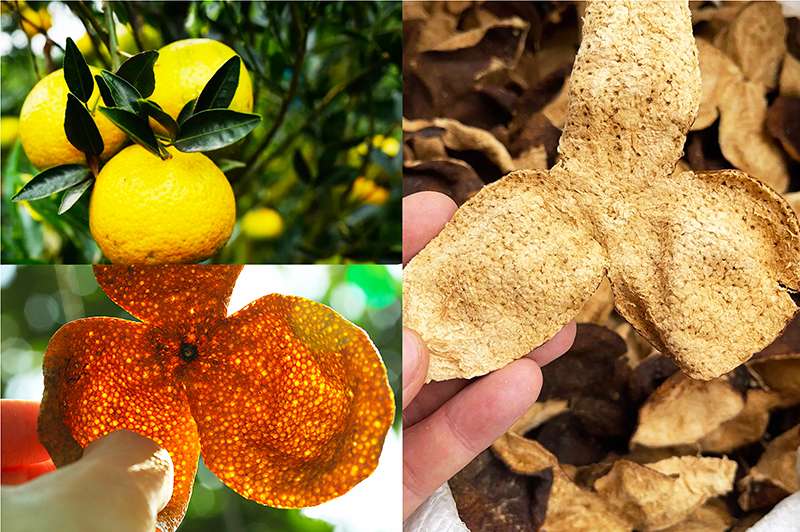
The Famous Xinhui Chen Pi
2. These selected oranges, of the highest quality, are cleaned and sterilized in preparation for the next step.
3. Use a knife to make a small hole in the top of the orange and use tongs or a spoon to remove the inside pulp. Great care must be taken in this process to avoid damaging the shell.
4. Clean the orange shell after taking out the pulp and then dry it naturally.
5. After the cleaned orange peel has been drained, it is ready to be filled with Yunnan Pu-erh tea. Only by selecting the best Pu-erh tea and Xinhui orange peel can they be aged in the later stage to produce the most complementary taste.
6. Remove toxins and bacteria with high temperature.
7. The workers will put the high-temperature sterilized orange peel directly in the strong sun for 3-7 days, and cover the cut "small hat". Then these oranges will enter the next stage - drying. In order to shorten the production time, some producers will also use high temperature and rapid drying to replace the natural drying process. However, many people believe that only the traditional natural drying process can preserve the late aging value of orange peel and Pu-erh to the greatest extent, and create the most authentic taste of orange.
8. The dried orange Pu-erh will be wrapped in cotton and vacuum-packed to maximize the aroma and flavor of tangerine peel and stabilize the taste.
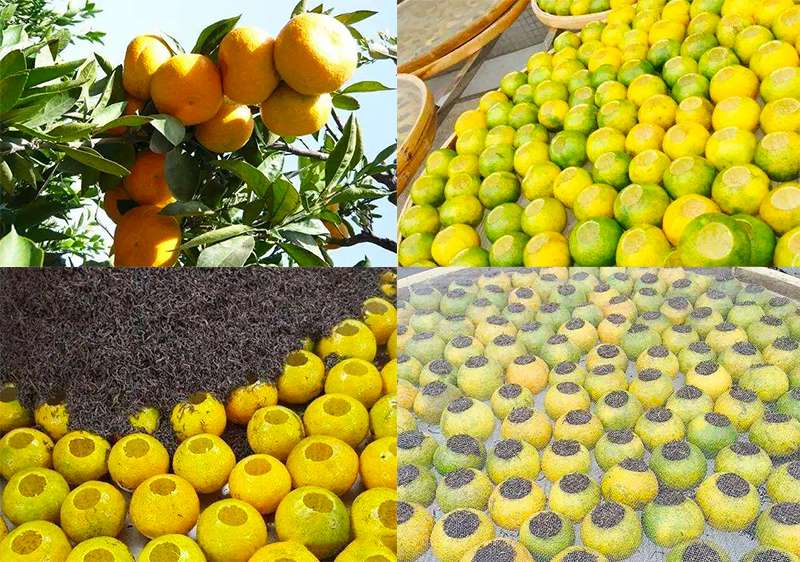
Some Production Processes Of Orange Pu-Erh Tea
The resulting tea has a unique and complex flavor profile that combines the rich, earthy taste of pu-erh with the bright, orangey notes of the mandarin orange. The aging process of Orange Pu-erh can range from several months to several years, depending on the desired flavor and intensity. Today, orange Pu-erh remains a popular type of Pu-erh tea and is enjoyed both in China and around the world.
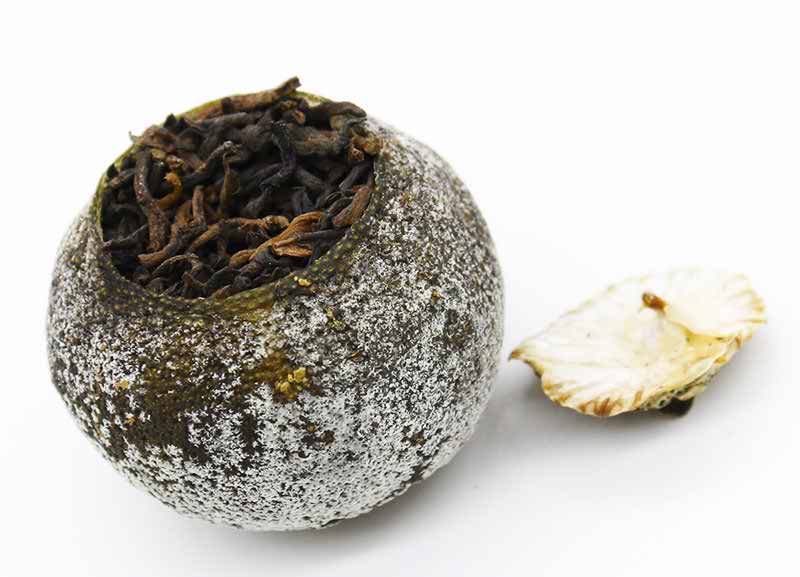
White Frost On The Surface Of Orange Peel Pu-Erh
What is the white frost on the surface of orange pu-erh?
Food mildew is a very common natural phenomenon, which mostly occurs in food and is caused by the propagation of microorganisms. Because the food itself contains protein, sugar and other ingredients, which will provide nutritional conditions for mold, when it is in an environment with appropriate oxygen and water, mold will multiply in large numbers in the food, thus causing food mildew. Only in the environment with sufficient nutrients, water, oxygen and proper temperature can mold have better reproductive ability. From the processing technology of tangerine peel Pu-erh, we can learn that tangerine peel Pu-erh is not easy to mildew when the packaging is intact and the storage environment is suitable (such as without moisture), because the moisture content of the finished product is very low.
The "white frost" on the surface of tangerine peel Pu-erh is called "orange oil crystal" and "brain crystal" in Xinhui, Guangdong Province. It is a crystal formed by the orange oil released from the orange peel after baking at high temperature during the production of tangerine peel Pu-erh. The mechanism of white frost formation is similar to that of persimmon cake, Chinese plum, dried sweet potato and other fruits, which is a normal phenomenon. The formation of white frost is related to the thickness of orange peel, the growth stage and the content of orange oil. For Xinhui orange, the more abundant the content of orange oil is, the more white frost will appear.
Can I still drink orange peel Pu-erh with white frost on the surface?
The answer is yes. The chemical components of white frost are some terpenes and alcohols, which are naturally formed according to the growth stage and process characteristics of orange peel. They have no impact on product quality and are harmless to the body. In fact, the more white frost produced, the better the quality of citrus, so it is a positive indicator in a sense.
| Chinese Gongfu Method | |
| Tea | 8g |
| Water | Gaiwan 3oz / 90ml |
| Time | 9 steeps: rinse one or twice,20s,30s,40s,50s,1m10s,1m30s,2m,2m30s,3m30s |
| Temperature | 100ºC/212ºF |
| Teapot Method | |
| Tea | 10g |
| Water | Teapot (8oz / 240ml) |
| Time | 5 steeps:30s,1m,2m,3m,4m |
| Temperature | 100ºC/212ºF |




